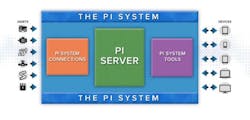Earlier this year I met with Richard Beeson of OSIsoft to discuss how OSIsoft, one of the more well-known providers of industrial data collection and analysis technologies, is adapting to industry trends around the Internet of Things (IoT). Given its history of industrial data collection/analysis technology deployment, it seems as if OSIsoft would suddenly be finding itself in the sweetest of positions for a technology provider to be in. After all, how often does a new trend—which happens to depend on the very thing you’ve been providing for decades—sweep across the industries to which you market your products?
If you’re not familiar with OSIsoft’s PI System, it captures data from sensors, manufacturing equipment and other devices to provide real-time insights that engineers, executives and partners can use to reduce costs, improve overall productivity or create new services.
In my discussion with Beeson, I noted my surprise at how relatively quiet OSIsoft had been during the past few years’ explosion of interest in industrial applications of the IoT concept. He assured me that OSIsoft had been active in the space, albeit not loudly; he also noted that much more information would be forthcoming.
Just a few weeks after we spoke, OSIsoft announced at its annual conference several new partner collaborations to accelerate connectivity with remote and mobile assets, IoT sensors and the PI System. Now, about six months after those announcements, OSIsoft has announced a new partnership with Petasense—a provider of software used to detect common defects like cavitation, wear and misalignment by analyzing vibration characteristics in critical rotating machines like motors, pumps and compressors.
According to the news release announcing this partnership, collaboration between OSIsoft and Petasense will “enable industrial customers to retrofit their machinery with wireless sensors and perform predictive maintenance using both asset and process control data. This will help plants eliminate unplanned downtime, improve plant safety and reduce repair and maintenance cost.”
The Petasense system includes a patent-pending wireless vibration sensor, cloud software and machine learning (ML)-based analysis of vibration patterns. The ML algorithms in Petasense’s software reportedly calculate a numerical health score of a machine in real-time, enabling plant managers to make informed maintenance decisions.
The release announcing this partnership points out Petasense’s expertise in this area via its history of logging more than 25 billion vibration readings.
Silicon Valley Power (SVP), the municipal electric utility owned by the City of Santa Clara, Calif., has already signed on to integrate the OSIsoft and Petasense systems. Currently, SVP monitors all its rotating machines with Petasense. The integration of the two systems is expected to enable SVP to correlate asset and process data and create predictive models that leverage vibration along with other process parameters.
Arun Santhebennur, cofounder of Petasense, says “any site that uses PI will be able to easily deploy and implement predictive maintenance at an extremely affordable price point.” To follow-up on this point, I asked Petasense to qualify Santhebennur’s statement about affordability. According to the company, a plant monitoring about 50 machines can typically expect to use about 150 motes and pay about $75,000 upfront and about $25,000 per year in recurring fees. More information about pricing can be seen here: https://petasense.com/products/pricing/
Leaders relevant to this article:


